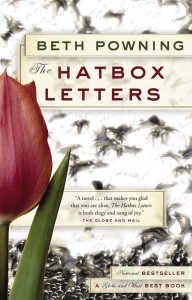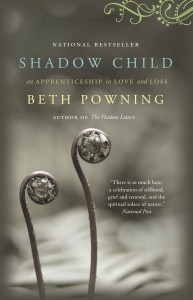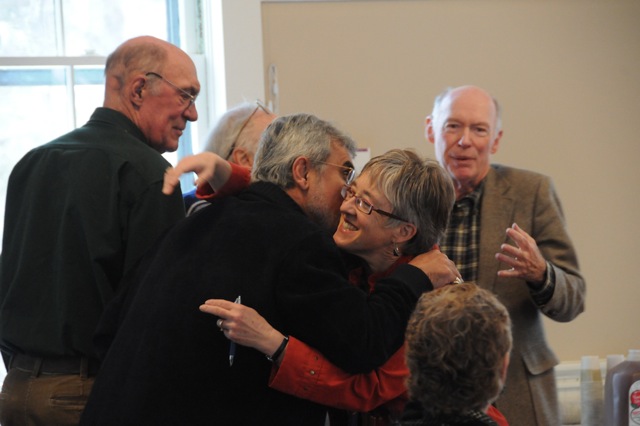“Don’t ever prejudge yourself or the possible outcome of what you are going to do…. You might start writing something, and it twists and turns, and you end up in an entirely different place.”
— Beth Powning, memoirist and novelist
Twice Beth has been guest author for my University of Toronto, School of Continuing Studies online course Memories into Story: Introduction to Life Writing, and I edited her memoir Edge Seasons (Knopf Canada, 2005). The following are questions some of my students asked Beth after reading three of her short memoirs: “Clotheslines,” “Hearing Loss,” and “A Grandmother’s Love.”
You’ve written both memoir and fiction. How do you decide what will work better for a particular story based on memory? Which do you prefer writing? Reading?
 Beth: My agent and I worried and gnashed our teeth over whether the subject matter of The Hatbox Letters should be written as novel or memoir. Finally, it was me who decided to write it as a novel. As I ponder your question, I realize how mutable the process of writing is. For example, I wrote “Clotheslines” as a short story, and then changed it into first-person memoir. It seemed to ring more true as a memoir. Every scrap of memory, every arresting “seed” is different. Usually it bears with it the way it wants or needs to be written: some are memoir-bearers, others demand to be fiction. Sometimes, though, it’s not clear—so then, as in my short memoir “Clotheslines,” I plunge ahead, try something to see if it works.
Beth: My agent and I worried and gnashed our teeth over whether the subject matter of The Hatbox Letters should be written as novel or memoir. Finally, it was me who decided to write it as a novel. As I ponder your question, I realize how mutable the process of writing is. For example, I wrote “Clotheslines” as a short story, and then changed it into first-person memoir. It seemed to ring more true as a memoir. Every scrap of memory, every arresting “seed” is different. Usually it bears with it the way it wants or needs to be written: some are memoir-bearers, others demand to be fiction. Sometimes, though, it’s not clear—so then, as in my short memoir “Clotheslines,” I plunge ahead, try something to see if it works.
I can’t emphasize enough the need to SIMPLY PLUNGE AHEAD! Writing is an adventure.
I actually love writing both memoir and fiction. I think memoir is easier for me. Fiction is more of a risk, more of a thrill. I love reading both—equally.
What did you write first, memoir or fiction?
Beth: First I wrote short stories, as a child. Then a novel, as my undergraduate thesis. Then another novel (never published). But it was in memoir that I found my “voice.” I envisioned myself kneeling at the window of our bedroom, listening to coyotes howling in the darkness. At the same time, I was feeling the loneliness of being an immigrant, the loss of my past. I connected this feeling with the shadowy coyotes who had drifted onto our land for no discernible reason: and a book was born. I was able to tell the story in a voice that was unfettered. Essentially, I was writing to myself, as if in my journal. Yet I knew, too, that this was a step away from journal writing, that I was shaping. I felt poetry in the subject, and let the poetry infuse the writing.
Sometimes I have a longing for this voice. It is like my deepest self.
When is a memory ready to be told as a story? Our view and interpretation of an event changes with time, and it seems the older memories tend to hold more emotional truth and fewer facts.
Beth: Interesting question. I think a memory is ready to be told as a story when it starts bugging you. It starts ASKING to be told. A writing teacher I had as an undergraduate told me to trust my intuition. Now I know what he meant. You have to listen, see if there’s a common thread running through your thoughts, your journal. It’s true that there may be some memories that are not ready to be told. I started writing about my grandparents many, many times, until finally I wrote The Hatbox Letters. I was seeking their truth, and thus a way in which I could understand and lose my desperate romanticization of my childhood.
There is no real answer to your question. The writing life is one of trying, failing, trying, succeeding. I write memoirs about things that happened yesterday. I write about my childhood. If the story is ready to be written, somehow it remains alive as you are writing it. If not, it eludes you.
 I wrote a story about a miscarriage that I had. I wrote the story about three months after it happened. The story was raw, powerful, filled with vividly remembered details and undigested pain. Rage and sorrow. Sometimes those are the best. Don’t ever prejudge yourself or the possible outcome of what you are going to do. Just dive in and swim. You might start writing something, and it twists and turns, and you end up in an entirely different place.
I wrote a story about a miscarriage that I had. I wrote the story about three months after it happened. The story was raw, powerful, filled with vividly remembered details and undigested pain. Rage and sorrow. Sometimes those are the best. Don’t ever prejudge yourself or the possible outcome of what you are going to do. Just dive in and swim. You might start writing something, and it twists and turns, and you end up in an entirely different place.
Where do you go when you really need to hunker down and simply … WRITE?
Beth: With my latest novel, I worked at my desk in the house. That was because I am using too many reference books to haul up to the sauna. (It is a historical novel, and I would have to check details.)
I also have found that I like to be closer to people now. It’s odd. But our house is usually dead quiet, and I yell “I’m writing!” if someone blunders into the kitchen (downstairs) during the morning.
I have gone to the Banff Centre quite a few times and worked at the Leighton Artist Colony, and that is truly wonderful because you can FEEL the intense creative energy sizzling in the air.
Do you set yourself daily goals?
Beth: Sometimes, not always. I write 3 to 4 hours a day. I can’t sustain any longer than that. When I’m writing a book, I often set myself a certain number of pages a month, then break that down into weeks, and have a goal of weekly pages. I find that helps.
Do you start with an outline or just let the words flow?
Beth: The one book that I started with an outline was Shadow Child. The title and the outline came like sudden fire, one morning. All my other books have been a process of thinking, and taking notes, and reading the notes, and then being inspired by the notes themselves to take more notes, until I can’t stand it anymore and just start to write.
What is your writing process? Our instructor, Allyson, has provided many good suggestions. Natalie Goldberg goes to a local coffee shop, opens a notebook and starts to write. Peter Elbow, in his book On Writing, advises to let words fall out, “make a mess.” I am trying to develop a process that will fit into my busy life. What suggestions do you have?
Beth: First and foremost, I keep a journal. It is large, with unlined paper. I use a black fountain pen. It is where I talk to myself about what I am feeling, what I dream of writing. I write all the time, in a structured way. Now that I can be a full-time professional writer, I come to my desk at 9 every morning. BUT. It was not always the case. I used to work in our family business. Then I would write in the afternoon. Once, I got up at 4 a.m. to write. The point being that I have always been driven to make time to write. And yes, I like the “make a mess” theory. I always take notes, write around the idea of what I’m going to write, but then a moment comes when I begin. Once you begin, something else kicks in. The words themselves put up roadblocks, steer you in different directions, take you down blind alleys, make you back up and try new avenues.
In memoir does an author maintain the same style from one work to another, unlike in fiction, where he or she might adopt different styles?
Beth: I think this is a good insight. When I write what I call “personal essays” it feels like I’m playing jazz on an instrument I know very well. I am talking to myself, in a particular voice. I’m trying to sort out this amazing journey we are all on. Whereas with fiction, I am an actor. I am inside other people, wondering what the world looks like to them, trying to find their voice. I’m making up a world. The style changes.
In the three stories by you that we read, did you remove anything from earlier drafts that you had initially felt was important but that didn’t fit with the story? How do you structure your writing?
Beth: Yes, I always remove things, and stuff was removed from all of those pieces. I start with a fragment, usually several visual images. The combination of these images (clotheslines waving freely in the wind versus clotheslines dead in a basket in the nursing home) makes me see and feel the underlying theme. I scribble that theme somewhere … loosely … what is the story REALLY about, at its core? Then I close my eyes, sit poised over the keyboard, waiting. I visualize scenes and write them as they come to me. I do a lot of rearranging, later, and cutting.
You can read the three short memoirs referred to in this interview in PDF form by visiting www.powning.com and clicking “Beth,” then “Resume,” then scrolling down to “Recent Magazine Articles.”
Read Part 2 of this interview.
BETH POWNING is the author of three books of literary non-fiction/memoir: Seeds of Another Summer, which won the New England Bookseller’s Association Discovery Award and was nominated for the Rutstrum Author’s Award; Shadow Child, short-listed for the Edna Staebler Award for Creative Non-Fiction; and Edge Seasons, a Globe and Mail Best Book. Her best-selling novel The Hatbox Letters was long-listed for the Impac Dublin Literary Award. Her latest novel, The Sea Captain’s Wife, was published by Knopf Canada in 2010 and by Penguin Plume USA in 2011. It was short-listed for the Thomas Head Raddall Atlantic Fiction Award and is a Barnes and Noble Discover Award Book. She lives in New Brunswick with her artist husband, Peter Powning.
As of Fall 2011, Allyson Latta’s University of Toronto, SCS, online course Memories into Story will be offered through The New York Times Knowledge Network. This 10-week course explores memoir, personal essay and experience-based fiction, and may be taken as a credit toward a Certificate in Creative Writing. Register here for Fall 2011 (Sept. 19 to Nov. 28) or Spring 2012 (Apr. 9 to June 18).
